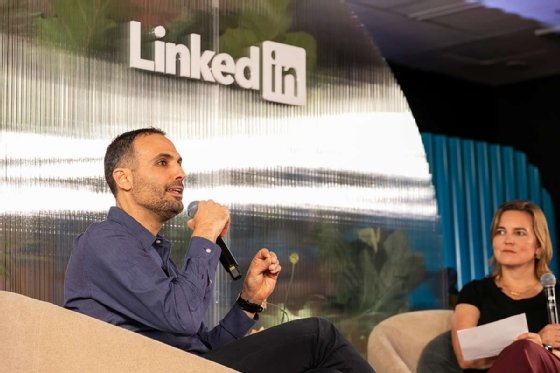
Getty Images
LinkedIn unveils AI updates for business users, job seekers
New features for job applicants, recruiters and businesses include personalized writing suggestions, more advanced search capabilities and AI conversations within LinkedIn Learning.
NEW YORK -- LinkedIn has developed a series of AI tools and features intended to enhance user experience for job seekers, recruiters, sales teams and other business users.
The updates, announced this week at an event for reporters and content creators, are part of the professional networking platform's broader strategy to integrate AI across its products. The AI features aim to give users more tailored insights and customization options, but they come with challenges and considerations.
AI updates to LinkedIn Premium
A major announcement was the general availability of the AI-powered Premium experience, which offers personalized insights and recommendations based on users' profiles and activities. The AI-powered features are currently rolling out to all Premium subscribers.
The AI tool helps users draft their Headline and About profile sections by analyzing existing profile content to highlight skills, education and experience. For messaging, it suggests personalized drafts for initiating conversations with recruiters, connections and prospective customers.
"Where personalization comes into action here is that we know you as a member, and then we know who you're trying to reach out to," said Prashanthi Padmanabhan, vice president of engineering at LinkedIn, in an interview with TechTarget Editorial. "We help draft that message with those insights so that it doesn't feel like a robotic, out-of-the-box outreach message."
During a demonstration of the Premium AI tools for TechTarget Editorial, LinkedIn representatives explained that the underlying algorithms draw on broader LinkedIn data in addition to user info. For example, the generative AI model that the platform uses to revise profile headlines was fine-tuned on data from profiles that attract high numbers of recruiter clicks, a spokesperson said.
Similarly, the message generation tool uses feedback from recruiters and users about preferred message content. This excludes private data from direct messages, another spokesperson said.
LinkedIn positions these features as ways to alleviate the "blank page" problem, while being careful to avoid promoting use of AI-generated content without review.
"We wanted to make sure professionals feel in control," said Tomer Cohen, chief product officer at LinkedIn, in an onstage conversation with Jessi Hempel, senior editor at large at LinkedIn. He compared AI to a passenger offering guidance, while the human user "is the one driving the car."

But even when viewing the AI recommendations as a starting point, not a final product, some users might still find the suggestions too stilted or general. Taylor -- a job seeker working in tech who asked to be identified only by first name because her current employer is unaware of her search -- shared her experiences testing the Premium AI features with TechTarget Editorial.
"While the new text isn't exactly wrong, it's also not completely accurate," she said, in reference to the AI-generated suggestions for her profile. "I can tell that the AI just took information from my past jobs and put it all together in sentences rather than bullet points."
"I don't want to use the AI tool as a substitute for thinking and writing about myself," she added.
In addition, LinkedIn is introducing "AI-powered insights" on posts that will appear directly in Premium users' news feeds, suggesting prompts and follow-up questions. Users can click these prompts to engage with a generative AI chatbot about the topics raised in the post.
For job posts, a similar feature helps Premium subscribers find roles that match their preferences and assess their fit for a given position. The tool offers skill development tips, drafts cover letters and suggests resume enhancements.
But similar to the profile suggestions, Taylor found that the job insights feature lacked sufficient specificity. The AI tool told her that her profile aligned well with the job and that she might be ready to apply, suggesting tips such as highlighting familiarity with the specific tools mentioned in the job description.
"This is not bad advice, but I could have skimmed the job listing myself and thought the same things," she said.
When she clicked a suggested prompt to get more details on the work-life balance at the company in question, she again received a generic answer, stating that the organization "offers programs to help you live your best life -- both physically and financially."
"I need more information than that if I'm going to decide whether I should apply to a place," she said.
Updates for LinkedIn Business users and recruiters
The company also announced several updates for LinkedIn Business users, including non-AI personalization for small and medium-sized businesses, and AI enhancements to recruiter search. The small business features are expected to be available globally by the end of July, while the recruiter updates began rolling out last fall and will soon be available to global English-language customers.
Small businesses can now create Premium Company Pages, which offer customizable elements visible to customers and partners, as well as insights for businesses' on-page engagement. One new tool, the Custom Button, lets business owners add personalized call-to-action buttons to their LinkedIn profiles, posts and messages. These buttons can prompt actions like visiting a website or booking an appointment.
For recruiters, the AI integration enhances search capabilities by recommending additional skills to target and expanding search parameters beyond job titles. In a demo for TechTarget Editorial, a LinkedIn spokesperson showed how a recruiter's search for a data analyst might also surface consultants and data scientists with similar skills.
The AI-powered recruiter search also displays the gender balance of candidate results, and it suggests locations and companies that could improve gender diversity in hiring. The feature was developed in line with Microsoft's responsible AI principles, the spokesperson said.
Sales Navigator expands to journalists
LinkedIn's Sales Navigator tool, originally designed for sales professionals to research leads and accounts, is now being rolled out to journalists.
Sales Navigator's search function lets users filter potential sales leads -- or sources, for journalist users -- by criteria such as past employment, seniority and location. Users can also create custom lists for individuals and companies that will prompt relevant alerts. While Sales Navigator was initially created to help sales professionals identify and prioritize high-value prospects, the extended functionality aims to improve efficiency for journalists in tracking sources and companies of interest.
Likewise, the Account IQ feature offers insights into a company's strategic priorities, business challenges and financial health using LinkedIn data and public information. Originally designed for quickly gathering information about potential clients to inform sales outreach, this feature is now also being pitched as a way to streamline journalists' research and reporting.
AI features for LinkedIn Learning
LinkedIn Learning is also set to receive an AI update with personalized skill development coaching.
Users can access a chatbot within the LinkedIn Learning interface that recommends courses and strategies to address work challenges or professional development needs. The tool analyzes information about users' current role, career goals and skills, and uses generative AI to suggest skills to develop through LinkedIn Learning's content library.
Some courses will also offer a more unusual way to learn -- via interaction with AI versions of top instructors. This tool uses content produced by instructors to train an AI chatbot designed to imitate the real instructor. By integrating information about the learner's career goals and desired skills, the chatbot aims to create the impression of direct engagement with the expert.
LinkedIn tracks and monetizes these expert chatbot interactions to compensate instructors via royalties, the company said. But exact details on monetization are unclear, and such a tool raises questions about reputational risks, such as attributing potentially inaccurate AI-generated information to an expert's voice.
LinkedIn is currently piloting the expert advice feature with a few select instructors. The company will then decide on broader expansion based on the pilot's performance, Padmanabhan said in an onstage product announcement.

Techniques to mitigate generative AI hallucinations
A common and significant challenge of using generative AI is addressing hallucinations, or instances where AI generates incorrect or misleading information. In an interview with TechTarget Editorial, Padmanabhan detailed the elements of LinkedIn's technical architecture designed to mitigate this issue.
LinkedIn uses several OpenAI large language models via the Microsoft Azure Gateway as foundation models, including GPT-3.5, GPT-4 and GPT-4 Turbo. These models are then fine-tuned on LinkedIn data to optimize them for their specific use cases.
"The fine-tuning really comes into play when we want to enhance it with data that is very proprietary to LinkedIn," Padmanabhan said. "It should feel different than you just going to a ChatGPT interface and asking a question."
Next, the generative AI pipeline gives the fine-tuned LLMs access to factual information via retrieval-augmented generation (RAG). This approach uses LinkedIn's internal data and external APIs, such as the Bing web search API, to fetch relevant information.
The generative AI tools also use chain-of-thought prompting -- a strategy that encourages AI to reason through problems step by step -- to translate users' free-form queries into more structured, LLM-friendly prompts behind the scenes. The goal is to produce reliable outputs using RAG and prompt engineering strategies, without slowing down the user experience.
"You want to make sure it doesn't impact the latency or the performance of that experience," Padmanabhan said. "It's a balance between quality and responsiveness."
Managing data and accuracy challenges in the real world
Brenda Discher, senior vice president of business strategy and marketing at Siemens Digital Industries Software, also emphasized the importance of data accuracy and integration in a panel at the LinkedIn event.
"AI hallucinates," Discher said. "It's not always 100% accurate. And so we've had to pay very special attention now that we're putting AI in the products we deliver to our customers."
Discher shared the real-world example of a battery manufacturer using generative AI to optimize designs for a cooling unit, where inaccurate training data could have devastating consequences.
"We've really had to make sure we pay attention to the biases in AI," she said. "It's OK if your weather [prediction] might be a little bit off tomorrow, but it's not OK if you have a catastrophic issue with a mechanical part or a plane or an automobile."
Leadership decisions around AI also include discerning when adopting AI isn't the right approach.
"Be intentional about what you want the technology to do and what you don't want it to do," said Nickle LaMoreaux, chief human resources officer at IBM, in the same panel. "I think that that is something that some companies are getting wrong right now."
Lev Craig covers AI and machine learning as the site editor for TechTarget Editorial's Enterprise AI site. Craig graduated from Harvard University with a bachelor's degree in English and has previously written about enterprise IT, software development and cybersecurity.








